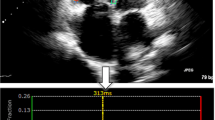Abstract
Background
Tissue Doppler imaging (TDI) is useful in quantifying regional myocardial function, but has a significant limitation of Doppler angle dependency. The recently developed 2-dimensional strain imaging (2DS), based on speckle tracking imaging (STI) technology, enables us to evaluate myocardial function independent of ultrasound beam direction. The aim of this study was to assess the mode of contraction of the left ventricle.
Methods
Circumferential, radial and longitudinal strains were measured in 18 segments (anteroseptal, anterior, anterolateral, inferolateral, inferior and inferoseptal walls at the base, mid-ventricle and apex) from apical and short-axis views using 2DS in 24 healthy subjects (mean age, 33 ± 5 years). We divided the left ventricle into 2 sites: septum (anterior, anteroseptal and inferoseptal walls) and free walls (anterolateral, inferolateral and inferior walls). We then compared the mode of contraction between the septum and free walls.
Results
At the base and mid-ventricular levels, circumferential strain was larger in the septum (−22.6 ± 3.6 vs. −18.3 ± 4.1% and −24.1 ± 4.8 vs. −18.4 ± 5.7%, respectively; p < 0.0001 each), and radial strain was larger in the free walls (33.4 ± 12.4 vs. 38.7 ± 14.5% and 37.8 ± 12.6 vs. 43.0 ± 11.6%, respectively; p < 0.001 each) at the basal and mid-ventricular levels, whereas both were relatively homogeneous at the apex. The longitudinal strain did not differ among walls.
Conclusions
Heterogeneous contraction is seen in the left ventricle. The septum mainly contracts circumferentially, whereas the free walls contract radially. 2DS is helpful in understanding the mode of 3-dimensional myocardial contraction.





Similar content being viewed by others
References
Buckberg GD, Weisfeldt ML, Ballester M, Beyar R, Burkhoff D, Coghlan HC, et al. Left ventricular form and function: scientific priorities and strategic planning for development of new views of disease. Circulation. 2004;110:e333–6.
Miyatake K, Yamagishi M, Tanaka N, Uematsu M, Yamazaki N, Mine Y, et al. New method for evaluating left ventricular wall motion by color-coded tissue Doppler imaging: in vitro and in vivo studies. J Am Coll Cardiol. 1995;25:717–24.
Stig U, Thor E, Hans T, Bjorn A, Otto AS. Myocardial strain by Doppler echocardiography: validation of a new method to quantify regional myocardial function. Circulation. 2000;102:1158–64.
Bach DS, Armstrong WF, Donovan CL, Muller DW. Quantitative Doppler tissue imaging for assessment of regional myocardial velocities during transient ischemia and reperfusion. Am Heart J. 1996;132:721–5.
Gorcsan J 3rd, Strum DP, Mandarino WA, Gulati VK, Pinsky MR. Quantitative assessment of alterations in regional left ventricular contractility with color-coded tissue Doppler echocardiography. Comparison with sonomicrometry and pressure–volume relations. Circulation. 1997;95:2423–33.
Derumeaux G, Ovize M, Loufoua J, Andre-Fouet X, Minaire Y, Crivier A, et al. Doppler tissue imaging quantitates regional wall motion during myocardial ischemia and reperfusion. Circulation. 1998;97:1970–7.
Notomi Y, Lysyansky P, Setser RM, Shiota T, Popovic ZB, Martin-Miklovic MG, et al. Measurement of ventricular torsion by two-dimensional ultrasound speckle tracking imaging. J Am Coll Cardiol. 2005;45:2034–41.
Miyazaki T, Tatara K, Mori K, Inoue M, Hayabuchi Y, Kagami S. Segmental myocardial strain of the left ventricle in patients with duchenne muscular dystrophy using two dimensional speckle tracking echocardiography. J Echocardiogr. 2008;4:100–8.
Kaga S, Mikami T, Onozuka H, Omotehara S, Abe A, Yamada S, et al. Right ventricular diastolic dysfunction in patients with left ventricular hypertrophy: analysis of right ventricular myocardial relaxation using two-dimensional speckle tracking imaging. J Echocardiogr. 2009;7:25–33.
Reisner SA, Lysyansky P, Agmon Y, Mutlak D, Lessick J, Friedman Z. Global longitudinal strain: a novel index of left ventricular systolic function. J Am Soc Echocardiogr. 2004;17:630–3.
Leitman M, Lysyansky P, Sidenko S, Shir V, Peleg E, Binenbaum M, et al. Two-dimensional strain––a novel software for real-time quantitative echocardiographic assessment of myocardial function. J Am Soc Echocardiogr. 2004;17:1021–9.
Young AA, Imai H, Chang CN, Axel L. Two-dimensional left ventricular deformation during systole using magnetic resonance imaging with spatial modulation of magnetization. Circulation. 1994;89:740–52.
Moore CC, Lugo-Olivieri CH, McVeigh ER, Zerhouni EA. Three-dimensional systolic strain patterns in the normal human left ventricle: characterization with tagged MR imaging. Radiology. 2000;214:453–66.
Hurlburt HM, Aurigemma GP, Hill JC, Narayanan A, Gaasch WH, Winch CS, et al. Direct ultrasound measurement of longitudinal, circumferential, and radial strain using 2-dimensional strain imaging in normal adults. Echocardiography. 2007;24:723–31.
Sun JP, Popović ZB, Greenberg NL, Xu XF, Asher CR, Stewart WJ, et al. Noninvasive quantification of regional myocardial function using Doppler-derived velocity, displacement, strain rate, and strain in healthy volunteers: effects of aging. J Am Soc Echocardiogr. 2004;17:132–8.
Fogel MA, Weinberg PM, Haselgrove J. Mechanics of the single left ventricle. A study in ventricular–ventricular interaction II. Circulation. 1998;98:330–8.
Bharati S, Lev M. The pathology of congenital heart disease. 1st ed. Armonk: Futura Publishing Co; 1998. p. 403–19.
Weinberg PM. Pathologic anatomy of tricuspid atresia. In: Rao PS, editor. Triduspid Atresia. 2nd ed. Mount Kisco: Futura Publishing Co; 1992. p. 81–100.
Streeter DD Jr, Spotnitz HM, Patel DP, Ross J Jr, Sonnenblick EH. Fiber orientation in the canine left ventricle during diastole and systole. Circ Res. 1996;24:339–47.
Greenbaum RA, Ho SY, Gibson DG, Becker AE, Anderson RH. Left ventricular fibre architecture in man. Br Heart J. 1981;45:248–63.
Cheng A, Nguyen TC, Malinowski M, Daughters GT, Miller DC, Ingels NB. Heterogeneity of left ventricular wall thickening mechanics. Circulation. 2008;118:713–21.
Author information
Authors and Affiliations
Corresponding author
Rights and permissions
About this article
Cite this article
Motoki, H., Nakatani, S., Abe, H. et al. Heterogeneous contraction of the left ventricle demonstrated by 2-dimensional strain imaging. J Echocardiogr 8, 33–39 (2010). https://doi.org/10.1007/s12574-009-0027-z
Received:
Revised:
Accepted:
Published:
Issue Date:
DOI: https://doi.org/10.1007/s12574-009-0027-z




